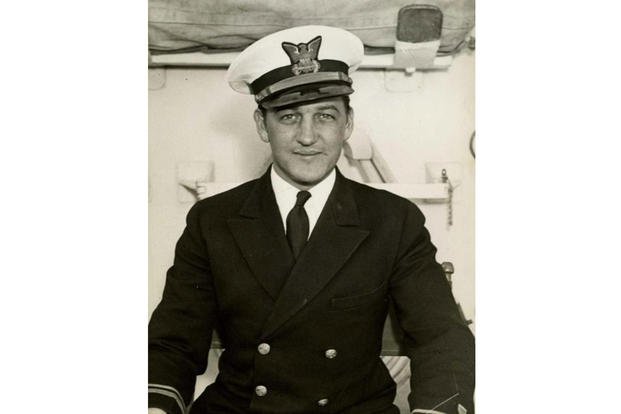 |
Lt(jg) James Crotty PHOTO : USCG |
Lt(jg) James Crotty PHOTO : USCG
His remains are being brought back to America to be buried with full military honors in Lawanda, New York next to his parents. The Commandant of the Coast Guard Admiral Karl L. Schults is expected to attend and present to the family the Filipino Veterans of WWII Congressional Medal of Honor, a special military award that commemorates the bond between the Filipino partisans and escaping Americans who fought the Japanese Imperial forces during the Japanese occupation of the Philippines.
Lt. James "Jimmy" Crotty is thought to be the only active-duty Coast Guardsman in the Philippines when the forces of Imperial Japan attacked there three days after Pearl Harbor.
Crotty was the one known Coast Guardsman on Corregidor. His single handed service was was pivotal in earning for the Coast Guard the Philippines Battle Streamer. The Coast Guard would not return in numbers to the Philippines until the return of General McAuthor's forces in which the Coast Guard provided many of the assault boat crews. .Crotty could be said to have single-handedly engaged in "joint operations" of the services, now the hallmark of today's U.S. military, The sneak attack at Pearl Harbor on Dec. 7, 1941, and the surprise on Manila on Dec. 10 had tested the nation's resolve, Crotty appeared to made of sterner stuff. He fought the invaders from the deck of the Navy minesweeper Quail. He also participated in raids with Marines of the 1st Battalion, 4th Marine Regiment. Crotty fought the enemy from Army artillery positions on the island fortress of Corregidor, ("The Rock.").
The out-numbered and out-gunned U.S. troops on the Bataan peninsula in the Philippines were ordered to surrender in April 1942, This surrender led to the the brutal "Death March" to the infamous Cabanatuan prison camp . Under relentless bombardment, Corregidor surrendered in May. Crotty was sent with thousands of others by cattle car to Cabanatuan, where, according to camp survivors, he died of diphtheria in July 1942,. He was 30 years old at the time of his death.
Lt, Crotty's remains ware buried in a mass grave at the Cabanatuan . After the war the commingled remains from Grave No. 312 Cabanatuan were transferred to the Manila American Cemetery and Memorial. For more than 70 years, Lt. Crotty was listed as an "unknown."
The incredible work of the Defense POW/MIA Accounting Agency (DPAA) succeeded in identifying Crotty's remains in September 2019. Lt. Crotty is believed to be the last Coast Guard POW/MIA (missing in action) from WWII whose remains will be identifiable. There are about 600 others, but almost all were lost at sea.
This recovery of the remains of an American hero is another in a stunning series of recoveries and identification of military remains by a specialized unit headquartered in Hawaii called the Defense Prisoner of War/Missing Personnel Office (DPAA) . This office was established in 2015 after the Joint P.O.W./M.I.A. Accounting Command and the Defense Prisoner of War/Missing Personnel Office were merged. D.P.A.A. is responsible for locating and identifying the bodies of the tens of thousands of American military personnel who died as prisoners of war or who were considered “missing in action” from World War II to the present. They are doing amazing work.
 |
| Defense Department photo |
The case of Lt. Crotty has drawn more attention than most of their cases because of the unique story behind the demise of Lt. Crotty. Crotty joined escaping Navy, Marine Corps, Army personnel and Filipino partisan groups which in turn helped create the Philippine guerrilla resistance. Only one Coast Guardsman was taken prisoner by the Japanese and he did not survive the experience. Lt. Crotty whose body is finally coming home.
The work of the DPAA may never be finished. From the Korean War, there are more than 7,600 still missing. World War II,counts close to 73,000 missing. Vietnam, has 1,597 missing. DPAA estimates that 30,000 are deemed “recoverable,” that estimate excludes the deep-water losses like ships and submarines as well as aircraft that crashed at sea. Such wreckage is sometimes serendipitously found and when it is, the DPAA goes to work to individually identify any remains recovered. Today the number of missing in action or unidentifiable combat dead in our 20 years + of Middle Eastern combat is very small. Generally the battle field dead were wearing "dog tags" and their bodies recovered within hours of their deaths. The enemy has rarely controlled the battle field for very long in these conflicts. The "fog of war" in the Middle Eastern conflicts has been centered on distinguishing friend from foe , and reducing "Collateral Damage". This seeming "lull" in MIAs provides the DPAA with some breathing room for clearing their back log of cases. We never know when a different kind of conflict will result in more traditional "Fog of War"with the greater number of MIAs that goes with it. Time to thank Almighty God for the return of LT. Crotty's remains and congratulate the DPAA on a job well done.
No comments:
Post a Comment